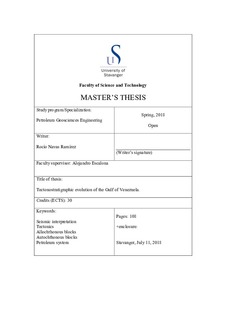| dc.contributor.advisor | Escalona, Alejandro | |
| dc.contributor.author | Navas, Rocio | |
| dc.coverage.spatial | Venezuela | nb_NO |
| dc.date.accessioned | 2018-09-27T10:29:41Z | |
| dc.date.available | 2018-09-27T10:29:41Z | |
| dc.date.issued | 2018-07-11 | |
| dc.identifier.uri | http://hdl.handle.net/11250/2564920 | |
| dc.description | Master's thesis in Petroleum Geosciences Engineering | nb_NO |
| dc.description.abstract | The Gulf of Venezuela is located at the boundary between the Cretaceous-Cenozoic deformation zone of the South American and Caribbean plates. It is an underexplored area lying between the hydrocarbon-rich Maracaibo Basin and the emergent plays such as the Perla field (Late Oligocene to Early Miocene carbonates) located on the allochthonous terrane. Gravity data, stratigraphy, structural styles, and subsidence plots reveal three main basement provinces in the Gulf of Venezuela: (1) A western Paleozoic basement (Maracaibo province) with continental-affinity similar to those in the Guajira Peninsula and the Maracaibo Basin; (2) a central province covering the area of the Urumaco trough offshore with Meso-Neoproterozoic rocks (Urumaco province); and (3) an easternmost province, with Cretaceous Caribbean arc rocks, related to the Leeward Antilles island arc system (Caribbean province).
Two major interpreted strike-slip faults define the boundary between the main provinces. The Cuiza-Río Seco fault is the western flank of the Urumaco trough offshore and represents a structural and stratigraphic abrupt change that is proposed as the boundary between the Maracaibo autochthonous province and the allochthonous provinces. The Pueblo Nuevo fault is proposed to be the continuation onland of a major interpreted strike-slip fault, defining the boundary between the central and easternmost province. In addition, the Cuiza-Río Seco and Pueblo Nuevo faults accommodate strain partitioning as well as the Oca- Ancón fault but at different timing, due to oblique compression of the Caribbean plate against the South American plate.
Furthermore, a pop-up structure associated with the Sierra de Perijá is recognized in the southernmost Maracaibo province, allowing to define about ̴ 70-80 km of right-lateral strike-slip displacement along the Oca fault. This fault has a relevant role to the present-day basement configuration, since it has displaced eastwards and segmented the northern part of the basement provinces, resulting in a more complex distribution that needs to be considered to reconstruct the geologic history.
Considering the continuation of the Maracaibo block northwards, this region might hold promising opportunities for hydrocarbons exploration, where the Maracaibo Basin petroleum system might extends offshore into the Gulf of Venezuela. | nb_NO |
| dc.description.sponsorship | The Conjugate Basins, Tectonics and Hydrocarbons Project (CBTH) | nb_NO |
| dc.language.iso | eng | nb_NO |
| dc.publisher | University of Stavanger, Norway | nb_NO |
| dc.relation.ispartofseries | Masteroppgave/UIS-TN-IER/2018; | |
| dc.subject | Gulf of Venezuela | nb_NO |
| dc.subject | petroleum geology | nb_NO |
| dc.subject | petroleumsgeologi | nb_NO |
| dc.subject | tectonics | nb_NO |
| dc.subject | seismic interpretation | nb_NO |
| dc.subject | petroleum system | nb_NO |
| dc.title | Tectonostratigraphic evolution of the Gulf of Venezuela. | nb_NO |
| dc.type | Master thesis | nb_NO |
| dc.description.version | submittedVersion | nb_NO |
| dc.rights.holder | Navas Ramirez, Rocio 2018 | nb_NO |
| dc.subject.nsi | VDP::Matematikk og Naturvitenskap: 400::Geofag: 450::Petroleumsgeologi og -geofysikk: 464 | nb_NO |
| dc.subject.nsi | VDP::Teknologi: 500::Berg‑ og petroleumsfag: 510::Geoteknikk: 513 | nb_NO |
| dc.relation.project | The Conjugate Basins, Tectonics and Hydrocarbons Project: OP-10170 | nb_NO |
